|
FAQs about Giant Clam Disease, Pests &
Predators 5
Related Articles: Example Chapter
from NMA Reef Invertebrates book, on Giant Clams, Tridacnids, A Brief
Guide to the Selection and Placement of Tridacnid
Clams by Barry Neigut,
Bivalves,
Mollusks, Lighting Marine
Invertebrates,
Related FAQs: Tridacnid Health: Pinched
Mantle Syndrome in Giant Clams by Dr. David Basti, Deborah
Bouchard & Barry Neigut, Tridacnid Disease 1, Tridacnid Disease 2, Tridacnid Disease 3, Tridacnid Health 4, Tridacnid Disease 6, Tridacnid Disease 7, Tridacnid Disease 8, & Pest Snails (Pyramidellids...),
FAQs on Giant Clam Disease by Category:
Diagnosis,
Environmental, Nutritional,
Social, Trauma,
Pathogenic,
Treatments
Tridacnid Identification, Tridacnid Selection, Tridacnid Compatibility, Tridacnid Systems, Tridacnid Lighting, Tridacnid Placement, Tridacnid Feeding, Tridacnid Reproduction, Tridacnids 1, Tridacnids 2, Tridacnids 3, Tridacnids 4, Tridacnid Clam Business, Bivalves, Bivalves 2, Lighting Marine
Invertebrates,
|
.jpg)
|
|
Coral identification & gigas clam shell formation
question 9/23/08 WetWeb Staff, First I just wanted to
say thank you for providing such a wonderful service.
<Welcome> I just have two quick questions. First, regarding
Dendrophyllia, I purchased a few heads from two different online
vendors and can only positively identify one colony as
Dendrophyllia. I suspect that the second colony might be
Tubastrea, but I am really not sure. I was hoping that you
wouldn't mind taking a look at the picture attached and offer
your best guess as to what the second colony is. I know that the
only true way to determine the species is to examine the
skeleton, but your best guess would be greatly appreciated.
<The photo sent appear to be of the genus Dendrophyllia> My
second question is concerning the growth of my gigas clam. Once
again, this was an animal acquired from an online vendor. I have
had it for just about 3 months now and it is doing fine. I have
noticed about a half inch of new growth, but what concerns me is
the unusual shape of the shell. I'm guessing that since the
clam is doing so well, I really don't need to worry about it,
but I am curious to know if the growth pattern has a chance of
harming the clam as it grows larger. Pictures are attached for
your review. <Not to worry... growth will slow, the shell
change a bit going forward> Thanks in advance for your
response, and thanks once again for providing invaluable service.
Marc
<Again, welcome. Bob Fenner>
|
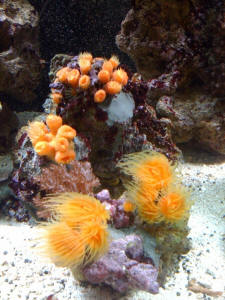 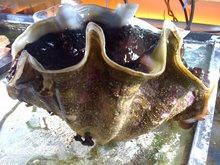 |
Did my new lighting kill my 4 year old Tridacna
maxima -- 09/12/08 Hello, I had a Tridacna maxima for about
four years. Purchased it about 3" in size and it grew to 6"
over the last 4 years. The clam had always been healthy. My tank is a
55gallon reef w/25 gallon sump, Only additives is Kalk Drip
½ tsp per gallon of top of water and trace elements through
bi-weekly 15 gallon water changes. Also use Phosbuster. <... this is
the most likely "causative agent" thus far... Clams, all live
need phosphate...> Calcium runs from 325-380 (maybe a bit low).
<Yes> PH 8.1 -8.2, Salinity 1.022, <Too low...> no
Nitrates, Nitrites or Ammonia. About two weeks ago I removed two of my
four 96w Power Compacts 10k/Actinic Smart Bulbs and added two 250w 20k
Metal Halide. A grand total of 692 watts. Transition- I ran the two
power compacts 2 hours then shut off and turned on the MH for 1 hour
and then Power Compacts on 2 hours. I increased the MH duration 1/2
hour each day until they were on a total of 4 hours per day with the
Power Compacts on for 4 hours per day. I noticed that the clam was
barley opening on the second day of transition. Figured it was
adjusting to the light. <Mmm... maybe not> After two weeks I
noticed that a whole bunch of my blue legged hermit crabs were eating
it from the mantle down. <Oops, yum!> I removed it from the tank
yesterday because it appeared close to death and did not want to poison
tank. I was wondering if I killed it with to <too> much light?
<Maybe this along with other stress sources, yes> The clam was
always at the bottom of the tank so it got less light then the rest of
the corals <... Clams are not corals> in the tank which all seem
to be fine with the exception of my Rose Bud anemone. It seems
stressed, eating fine but is shrinking and expanding and is also
wanting to move to somewhere else in the tank because it is releasing
it foot to try and move. Something is obviously amiss. <Yes...
again, the light, HPO4, spg... of what you mention> Aside from the
lighting the only thing I have changed in the tank was adding a medium
size frag of sun corals and small Acropora frags. Oh almost forgot I
have been able to maintain tank temperature of 75F-79F with the halides
by use of a fan. Tank is 75 when lights turn on and 79F when lights go
off 8 hours later. The Metal Halides are CoralVue Mogul Base style,
retrofit so they don't come with a UV shield. Do they need some
special UV glass between them and the tank? <Uhh, I'd be
contacting the manufacturer re... More and more such lamps come with a
coating on their glass, but I strongly encourage all to provide another
layer/barrier between the water and the lamps... for safety's
sake... to prevent damage (even explosion) from splash, spray> My
plan is to do a large water change this week, 55 gallons of the total
80 gallons of water volume, just in case something is wrong. Could the
clam had a predator that I could not see that was introduced from the
sun polyps or Acroporas or did I introduce the new lighting to
fast or likely something else in water? <Doubtful re the predator,
but the three items mentioned above... for sure> Any insight into
what may have killed my clam would be appreciated. It was one of the
oldest things in my reef and really disappointed that is now gone
especially when they can live so much longer than that. Brian
<I'd ditch the chemical filtrant, raise the spg, use a more
gradual photo-acclimation process. Bob Fenner>
Aiptasia inside Tridacna Crocea clam shell
(cannot scrape it!) 6/13/08 Hello crew, <Betsy> I just
purchased a ~5 inch crocea clam from another person who was
breaking down a tank. During acclimation I noticed an Aiptasia, but
it is not 'on' the shell of the clam, it is between the
layers of the shell right under the mantle, I declare it to be
unscrape-able. I tried to use one point of a tweezers (which barely
fit into the hole) to "squish" the Aiptasia (which
withdrew completely into the crack, you can see in the bottom
center of the photo). I was a little timid though, very afraid of
hurting the clam. From what I have read about Aiptasia, I imagine
that I did not successfully kill it. I read on your site FAQs that
Aiptasia can annoy the mantle of the clam (and boy, is it ever
close to the mantle!). I also read that injecting anything that
close to the clam might not be such a great idea. <Actually,
I'd either ignore this pest... or look into a really neat new
product by Red Sea... I saw this in action a few weeks ago at the
Interzoo industry show in Germany... an injectable that appears to
be "tasty" and non-toxic... that one can squirt into such
pests... they eat it... and dissolve> So, any ideas on how to
rid myself of this pest without injuring the clam? Also since
I'm writing, I plan to let the clam attach to a piece of
ceramic tile so I can place it on the sand bed. (I understand that
crocea's prefer to be on a hard substrate). Is a tile a good
idea? <Mmm, yes> The clam was living on the sand in the other
person's tank, from what I understand. My lighting is very good
( 6 overdriven T5 bulbs on Icecap 660 ballasts - producing a PAR of
about 350 on my sand bed). I would like to keep it on the sand bed
rather than in my rocks so that I get the best viewing angle on
it's mantle. <A very good point> Thanks very much,
Betsy
<Welcome. Bob Fenner> |
|
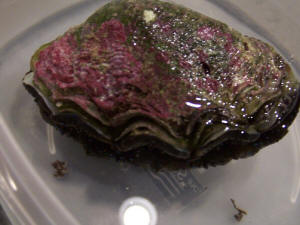
|
Injured Tridacna derasa'¦A Case Of Home
Invasion -- 04/05/08 Hello all, <<Greetings>> I have a
bit of a problem here and could use some advice.
<<Okay 'let's see what I can do>> To start
with, I have a 20g reef tank, maintain general good water quality -
weekly water changes, Ca-Alk supplement in morning before lights on, pH
8.3-8.5, 9-12dKH, Ca 380-420, <<Having both Alkalinity and
Calcium at the high end of the scale can lead to trouble 'as
Anthony explains here: http://www.wetwebmedia.com/calcalkmar.htm
>> Nitrate 3-5 (peaked at 5 when I lapsed for month without
getting more salt), 18g sump with 8g DSB, and SeaClone 100 skimmer. Now
for my problem....I have a 3" T. Derasa that I have had for about
2 months that has gotten "hurt"... One of my small C.
tricolor hermits got trapped by the clam somehow (I have seen them
picking at the algae growing on the shell and causing the mantle to
retract as they hang on the edge of the shell) with its 3/4"
Cerith shell directly in the clams intake siphon.
<<Mmm'¦>> I was running late for class and
couldn't get the clam to release before I left, and when I came
home tonight the crab was out but the clam is pretty torn up. The
excurrent side looks fine and was still expanded, but the intake is
heavily lacerated and very withdrawn. <<Not good>> Can the
clam recover from this? <<Possibly 'if its internal
organs have not been damaged as well>> Or would I be better off
euthanizing this specimen to save the rest of the tank from a dying
clam? <<I wouldn't 'yet. But do keep a close watch
on the clam and remove it at the first signs of further decline or
decay>> If it can recover, is there anything I can do besides
maintaining good water quality, or just hope. <<This is pretty
much all you can do 'although moving the clam to a
hospital/recovery tank would alleviate your fears of polluting the
display should the animal die>> Is this a common accident to
happen with Tridacnids and hermits/snails, or just a freak occurrence?
<<I seem to recall a similar incident with a snail that entered a
clam through its byssal opening a few weeks back 'but all in
all, I think such incidents are rare>> I know that crabs in
general should not be trusted with clams, but I never thought that a
small, grazing hermit could be so destructive in this way. <<Are
very opportunistic 'but the species you mention are not
generally known to 'attack' healthy clams if kept well fed. The
hermit likely just 'fell in' during the activities you
described earlier. And the bulk of the damage to the clam was also
likely self-inflicted while trying to eject the 'foreign
object'>> Thank you for your time and advice. BBB
<<Happy to assist...I do hope the animal recovers.
EricR>>
|
Turbo snail inside clam -03/28/08 First off, just want to
let u know that you have helped me immensely over the last two
years, so thank you. <Thank you, sorry for the delay.> I
have a strange problem. Last night I realized that my clam
(picture clam 1) about 6 inches long was unable to close its
shell, however it was Retracting and responding healthy. Upon
turning it over, I found that there was a turbo snail about the
size of a marble trapped in the joint. <How odd.> I tried
to dislodge the snail but it was in to deep and went through the
hole in the bottom of the Clam were the muscles that attach to
rock are. These muscles then closed the opening back shut. The
snail is now inside the clam. The clam can still not close but is
responding well, however it is not opening the top vents, when I
got home today this is what I found (picture Clam 2). The shell
still does not close so I assume that the snail is still inside
but it appears that the filtration part of the clam is on the
outside through the whole in the bottom. <Hmm, the picture is
a bit blurry. I can't be too sure exactly what part(s) of the
clam that is (that are hanging out). But it does look
uncomfortably like gill. Though, I'm not entirely sure
it's not just the byssus muscle.> It is still attached. Is
there a way to get the snail out or will it take care of itself?
Is the clam doomed? Is there anything I can or should do?
<This is really odd, but it doesn't look good. I've
never heard of this happening before with a turbo snail. I
suppose, maybe if the snail is still alive it might find its own
way out. But unfortunately, I don't know if too much damage
has already been done to the clam or not, for it to survive. If
you can't reach the snail, I can't think of anything else
you could do.> I have one more question. I have something
growing on my finger leather (picture finger leather). It looks
the same as what was on my Fuji leather last year that died from
the base up. Do you have any ideas on what it is and how to treat
it? <What happened to your Fiji leather last year? The photo
is a bit difficult to make out what's happening. Is it
detaching from the base?> Bryan Stone <Best, Sara M.>
Re: Turbo snail inside clam 3/30/08 The mass that is
outside of the clam has a large sac with a bunch of tiny
filaments attached to it. The whole thing is still attached. I
will try to get a better picture but it is white. Should I try to
go in and get the snail? <If you can see it and delicately get
it out, it might be worth a try. But to be frank, it just
doesn't look good... the clam might be past the point of
possible recovery.> My Fiji leather had this same
discoloration at the bottom and is slowly spreading upward as
this is doing? The tissue seams to get hard. <It might be
trying to move/reposition itself.> Yes the Fiji eventually
detached and appeared to kind of dissolve or rot from the bottom
up. This discoloration seems to have small black lines moving
vertically. As if it is growing. I have a good picture but by the
time I reduce the size down it loses definition. I can sent it
again if it helps. Again thank you for your help! I had them both
in this tank but the finger was still rather small when the Fiji
died a year ago. <Leather corals can sometimes detach
themselves from their bases when they're "unhappy"
with where they are for some reason (though they do this very
slowly). It sounds to me like this is what might have happened to
your previous leather (which was apparently unable to reattach
itself somewhere more favorable). Otherwise, I don't know
what else could be happening here, sorry.> Bryan Stone Sara
M.>
|
|
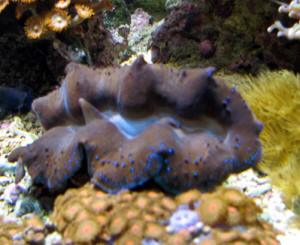 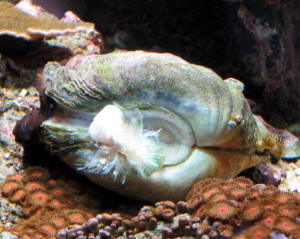 Yikes Yikes
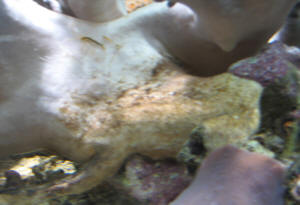
|
|
clam problem, English, no useful info., using WWM
3/26/08 last night before shutting down my light system on my
140 reef all of the animals and coral were fine open and happy
.this morning I awoke to a horrible sight my baby crocea was dead
.it is kind of hard to explain what it looked like when I took it
out of the tank there was this mass that had the consistency of gel.
I will be including a picture . I believe that to be what's left
of him. <Bizarre that this should happen so quickly... Your
pix are very hard to make out> I was wondering if it could of
been a snail .I have heard that there's a snail that attacks
clams . <... your English... and no searching...> The clam
was in the sand also I don't know if that a facto .also ph
8.2 ammonia 0 nitrate0,nitrite 0. in the picture with the clam
the watery looking stuff is like a jelly fish feeling to it .
texture <Read here: http://wetwebmedia.com/tridacdisfaqs.htm
and the linked files above. B>
Re: clam problem, English, no useful info, using WWM -
3/28/08 I don't know if this is useful information for
you or not (and like you said the pictures are not the clearest).
The second picture (the one of the snail) looks suspiciously like
a LR hitchhiker I removed from my main tank after I caught him
feeding on (what I think is) a tube worm or non mobile snail) of
some kind. I tried to do some research on the predator at the
time and found that it indeed was known to feed on other inverts
(especially the non-mobile types). <<I see>> I
can't remember where I found it now and tried looking for it,
but mine looks kind of like a gray tulip snail.
<<Mmm'¦best to 'evict' then>> Since
this is the first time I've written I'd also like to say
thank you for teaching me that everything (at least most
everything) I learned from my mother about keeping a marine tank
is incorrect. <<'¦?>> After reading through
your pages for the last 6 months or so I'm amazed that her
overstocked 29g long does as well. I also wish I had found you
before I had setup my tank (a 40g tall) I'd have made very
different decision if I had. <<Ah'¦>> Keep
up the good work, Jason
<<We are trying. EricR>>
|
|
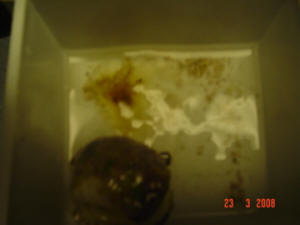 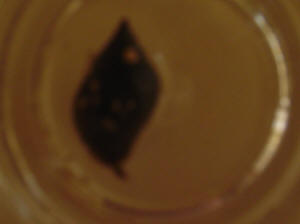
|
|
Clam troubles... no data of use, not
reading... 2/21/08 Hi! <Howzit?> I have a
newly setup 330g main tank and 70g sump setup in December. As a
part of the new tank I migrated from a well established 46 gallon
reef tank. I had a maxima clam and a Crocea clam I have kept for
over 2 years in my 46g tank. However, last week I lost my Crocea
clam and my maxima is fading quickly (clam not opening very wide,
sinking mantle, bleaching of mantle). The new tank water quality
is kept very clean, stable pH, temp, water parameters are great,
salinity 1.025, calcium is a bit low but climbing 350-380.
<Alkalinity, Magnesium?> I am dosing every other day w/ DT
phyto. <... of not much use in this setting> After the
Crocea perished I dosed the maxima in a separate container with
tank water and heavy dose of DT phyto, despite this the maxima is
still declining quickly. The tank is kept under 1600 watts of (4
x 400w HQI halides). The clam is kept on a flat rock laying in
the sand substrate. <... may well need to be elevated...>
Given the new tank would you suspect: The maxima clam size is
about 4". 1.) The tank is to new and does not contain enough
natural phyto and other items in water column needed for health
of this clam. <...> 2.) A water quality or chemistry
problem. <Possibly> 3.) A light problem <Likely>
Thanks for all of your help as always! Bryan <Please read
here: http://wetwebmedia.com/tridcacdisf5.htm and the linked
files above... You need to know a bunch more... and provide more
data... For now, read. Bob Fenner>
Re: clam troubles... lack of nutrient... 2/21/08
Thanks, I did some reading on that URL. <Okay> The maxima
perished. Alk is 11 dKH, calc is about 390. ammonia: 0 nitrites:
0: nitrates: barely detectable. I had always thought under
halides keeping a clam on the substrate was doable, <Mmmm>
I have seen several healthy looking clams in other tanks like
this. The tank is 30" tall and the halides are about 7"
off the top of the aquarium. I obviously want to figure out what
went wrong before buying anything else. <This depth... the
light would have to be directly above...> Given the slow
decline I didn't speculate it was a pest. <Agreed> The
only thing recently I have changed in the tank was the addition
of PhosBan media per your teams recommendation. <...! Clams
(actually all life... e.g. ADP, ATP...) absolutely require
"some" soluble phosphate... This sudden removal may
well have been a factor> Within 2 weeks, both clams are gone.
Coincidence? <Not likely> I have not tested phosphate prior
to this, and I had no reason to believe I had a phosphate
problem, I simply added it as a precaution for long term health.
<... I would not have done this... there are other, easier
means of phosphate limitation, control... Posted on WWM> Is
your bet still on light? <Partly... but am hedging/spreading
my bets more and more. How about you?> Best Bryan <Bob
Fenner>
|
Questions about crocea clam and an open brain
coral -02/06/08 Good afternoon, I hope this email reaches you
all well. I can't tell you much I (we) appreciate what you do
for us! Anyway, I have two questions I have searched for on WWM
archives (there's A LOT) and can find no clear answer for. In
fact, I'm a little confused. First, I have a question about a
red open brain I got last week. Picture attached. In the week I
have had it, I have seen no movement, no tentacles, no feeders, no
nothing! It has also lost a little color since I got him home. Last
night, I saw slime tentacles with little bubbles on the
"slime" which were extended about 4 inches above him. Is
this normal for a while as it gets used to the tank? <Usually,
yes, it can take some time for feeders/sweepers/etc. to come
out.> The only other invert near him right now is a small rose
bubble tip 8 inches away and up in a rock crevice. Also, on many
WWM archives, these should be placed directly onto the sand bed ,
which mine is. But, I saw some other WWM archives that said to
place it into a rock structure, since it gets irritated if sand is
blown in it http://www.wetwebmedia.com/trachyidfaqs.htm Which is
it? Sand or rock? <On the sand is preferable. However, if it
keeps getting covered in sand, you might want to prop it up on a
rock.> Second question, I also have a Tridacna crocea clam I
bought at the same time. When I placed him into the tank, I also
placed him into the sand with a piece of tile 1/4 inch under him in
the sand (did my research!) so he could put his foot onto
something, and although he looks very healthy and opens / closes as
he should, he keeps "knocking" himself over onto his
side. I don't want to keep adjusting him and causing more
stress than he probably already has. I know he should eventually be
moved onto a rock, I just wanted to keep him where he is so I
don't "light shock" him before I move him up. Any
suggestions? <The tile might be too flat or not the right
size/shape for it to "balance" itself on. Try a rock or
some other hard surface that it can sit balanced on.> Is he OK
on his side? <Not in the long term.> The sand grains you see
in the picture get blown out when he "exhales" (which is
what is knocking him over). I hope these don't seem like silly
questions.) Tank specs: 55 gal (w/10 gal partitioned sump holding
Chaeto algae) 4 inches of Aragonite live sand 40 - 50 lbs live rock
3 Ocellaris Clowns (introduced together last year) 1 Clarkii Clown
(plays nice with the O's) in a Sebae Anemone 1 Bubble tip
Anemone 6 nice stalks of Xenia (doing very well I might add) 1
Sailfin Tang 1 Six Line Wrasse various Zoos (small colonies)
Nassarius Snails and various small hermits, lots of amphipods,
copepods, and a few bristle worms the wrasse has yet to find. PH =
8.4 (evening) Ammo, Nitrates, Nitrites, Phosphates = 0 (hard to
believe on the last two, but that's what my test kit says)
Calcium 460 - 480 Alkalinity = 11 - 12 Magnesium 1300 - 1400 Shayne
McKean
<De nada,
Sara M.> |
|
 
|
Can Cyano kill clams? Oh yes 10/2/07 I
have a 55 gal saltwater aquarium. I'm having a bit of a problem
with Cyano. I've repositioned my powerheads so that there is water
circulation in all directions. <Helps> It seems to have gotten
much better except on the substrate around my Crocea clams. I purchased
a few queen conch, <Get too big...> some snails and a sand
sifting cucumber <What species? Some of these aren't "reef
safe"> to keep my substrate stirred up. I even stir it up
myself and try to siphon out the Cyano. <I would do this VERY
carefully> My question is this. I came home from work to find the
mantle of my clams rather withered and retracted. Upon closer
inspection I noticed I could see right through them to the substrate.
Could the Cyano bacteria on the sand have caused this or is it more
likely my cleaner shrimp or emerald crab (even though I've never
caught them in the same area as the clams) <Could be the Mithraculus
for sure... but also the BGA is a negative influence. Have you read on
WWM re various means of countering Cyano profusion? I would. Bob
Fenner>
| Clams making a fashion statement? Bleached
Tridacnids 9/23/07 Hey Gang :) <Lisa> Here I
am again with a question. (big surprise huh?) <Oh yes!> I
have 3 crocea clams in my tank. They've been there for about a
year. They all had pretty good color until about a month or so ago.
Now two of them are completely faded, the biggest has gone from
purple to brown. They otherwise seem very healthy. The light has
not changed since we upgraded in January to a 520 watt system which
provides about 5.7watts per gallon to our 90 gallon Oceanic
bowfront. I had the water tested Wednesday at the LFS just to
double check my own results, and the quality is excellent (Ph 8.3,
nitrates 0 nitrites 0, ammonia 0, phosphate 0). They
didn't test calcium, alkalinity was 13. SG is 1.026. <This
all looks okay... except that the clams do actually need some
nitrate, phosphate... and some folks speculate even ammonia> So
knowing lighting hasn't changed, water quality is excellent
(everything else is thriving), what can I do to help my clams
regain their color? <More nutrient I believe... What do you feed
these Tridacnids?> Thanks again so much, I'm lost without
y'all. Lisa <You have read here:
http://www.wetwebmedia.com/tridacfdgfaqs.htm and the linked files
above? Bob Fenner> |
|
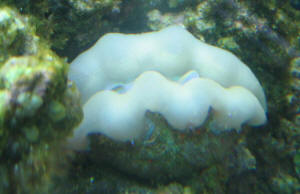 .jpg) Bad Bad
|
|
|

